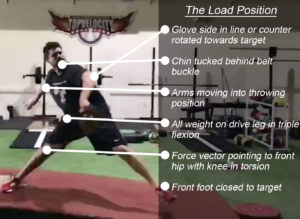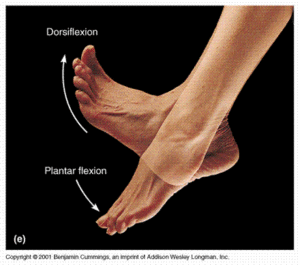 3X Pitching is a revolutionary approach to increase pitching velocity which holds the secrets to power pitching. The foundation of the approach is using triple extension (3X) of the drive leg to enhance hip to shoulder separation and pitching velocity. You can learn more about the science behind this power pitching approach in my latest article called, Scientific Proof that 3X is Key to Separation and Pitching Velocity.
3X Pitching is a revolutionary approach to increase pitching velocity which holds the secrets to power pitching. The foundation of the approach is using triple extension (3X) of the drive leg to enhance hip to shoulder separation and pitching velocity. You can learn more about the science behind this power pitching approach in my latest article called, Scientific Proof that 3X is Key to Separation and Pitching Velocity.
In another article here at TopVelocity.net, I defined a critical component to implementing 3X which is called the ankle kick. You can learn more about the ankle kick and it's role in the 3X Pitching mechanics in the article called, 3X Pitching and the Critical Ankle Kick. Once a pitcher has learned the power of the ankle kick to the 3X approach to pitching and has used the 3X Velocity System (throwing program) to implement the motor coordination around the 3X Pitching mechanics then it is important to begin working on the fine motor skills of 3X Pitching to help the pitcher master the entire approach and have a significant increase on pitching velocity.
The Fine Motor Skill of Dorsiflexion
 The fine motor skills of 3X Pitching exist at the beginning and the end of the kinetic chain. The first one, that is the key to the success of a pitcher implementing 3X effectively, supports the power of the ankle kick. This fine motor skill is called Dorsiflexion. This is the pulling of the toes towards the shin like in the picture of the foot. Dorsiflexion has been proven to enhance power in the extension of the leg of runners and jumpers. Using this ankle position of the drive leg during the "Load" position and just before the critical ankle kick in the 3X Pitching mechanics, is the key to enhancing drive leg power which will support complete triple extension and the conversion of the stride power into torque.
The fine motor skills of 3X Pitching exist at the beginning and the end of the kinetic chain. The first one, that is the key to the success of a pitcher implementing 3X effectively, supports the power of the ankle kick. This fine motor skill is called Dorsiflexion. This is the pulling of the toes towards the shin like in the picture of the foot. Dorsiflexion has been proven to enhance power in the extension of the leg of runners and jumpers. Using this ankle position of the drive leg during the "Load" position and just before the critical ankle kick in the 3X Pitching mechanics, is the key to enhancing drive leg power which will support complete triple extension and the conversion of the stride power into torque.
Dorsiflexion is an important tip for those 3X pitchers who are struggling with mastering 3X Pitching and using 3X to create optimal hip to shoulder separation. Most pitchers who struggle with implementing a complete 3X before front foot strike do not have the ankle in dorsiflexion during the"Load" position. These pitchers would benefit instantly from this mechanical adjustment of the drive leg foot.
3X Pitching and the Power to Torque Connection
Before diving into the details of dorsiflexion let's first cover the power to torque connection with 3X Pitching. 3X Pitching proves that power pitching begins in the stride phase. This is from leg lift to front foot strike. Harder throwers generate more stride power than low velocity pitchers. This stride power comes from the triple extension of the drive leg as it generates ground reaction forces and in the stabilization of the landing leg at front foot strike. Not only do high velocity pitchers generate more force production through the drive leg than low velocity pitchers but they accelerate this force just before or just at front foot strike. This force is then converted into torque through hip to shoulder separation.
The most challenging component of the 3X Pitching mechanics, that separate high velocity pitchers from low velocity pitchers, is 3X into hip to shoulder separation. This connection will have a significant increase on a pitchers velocity. This connection links the power of the stride into the rotation torque of the upper kinetic chain. Most pitchers who struggle with increasing pitching velocity, struggle with this connection of stride power into rotation torque.
The key to connecting 3X into hip to shoulder separation is dorsiflexion which supports an explosive leg drive. Implementing this fine motor skill into your 3X Pitching mechanics will help a low velocity pitcher make that 3X to separation connection.
The Science Behind Dorsiflexion and Power Pitching
To fully understand the power of dorsiflexion the Sport Medicine Unit, CRR, SuvaCare, Sion, Switzerland, put together a case study called, Influence of initial foot dorsal flexion on vertical jump and running performance. Here is the results of the study:
As compared with standard shoes, dorsiflexion (DF) shoes significantly improved the height of Squat Jumps (SJ) (31 +/- 4 cm vs. 34 +/- 4 cm, p = 0.0001), Counter Movement Jumps (CMJ) (32 +/- 4 cm vs. 34 +/- 4 cm, p = 0.0004), and Continuous Jumps (CJ) (17.5 +/- 4.2 cm vs. 22.0 +/- 6.0 cm, p = 0.0001). Speed at take off was also significantly higher. Mean power significantly increased in SJ and CJ but not in CMJ. Oxygen uptake was not different between conditions (p = 0.40). Dorsiflexion shoes induce a significant increase in jump performance. These results are in accordance with the concept that a DF of the ankle may induce an increase of the length and strength of the triceps surae (higher torque). However, wearing DF shoes did not require more energy during running. Dorsiflexion shoes could be used to increase jump performance in several sports such as volleyball in which jump height is essential.
Read entire study here: http://www.ncbi.nlm.nih.gov/pubmed/19918197
This study is proof that dorsiflexion will increase power. The study points out that this will help jumpers and runners and if they had an educated understanding of the mechanics of power pitching, they would more than likely state pitching as a benefactor.
If we couple the case study above with the case study from the Department of Orthopaedic Biomechanics, Johns Hopkins University, Baltimore, Maryland, called, Characteristic ground-reaction forces in baseball pitching, then we have proof that the fine motor skills of the beginning of the kinetic chain will influence the fine motor skills at the end. To understand this link let's look at the results of the study:
Wrist velocity was found to correlate highly with increased leg drive. This study validates the clinical impression that the lower extremity is an important contributor to the throwing motion.
Read the entire study here: http://www.ncbi.nlm.nih.gov/pubmed/9474404
These two studies illustrate the importance of pitching from the ground up when it comes to pitching velocity. This means you should spend as much time on the fine motor skills of the feet as you do on the fine motor skills of the hand.
The Key to Implementing Dorsiflexion into the Pitching Delivery
The only way a pitcher will implement dorsiflexion into their pitching delivery is by making sure the drive leg foot is flush with the rubber and remains flush with the rubber until 3X occurs. Most low-velocity pitchers who do not use dorsiflexion in the drive leg start with the toes on the rubber and the heel off. Some of those low-velocity pitchers who do start with the drive leg foot flush with the rubber will swivel the foot from lift to the "Load" position which will move the heel off of the rubber before 3X occurs. This will also prevent dorsiflexion and reduce power.
To prevent the drive leg foot heel from swiveling off the rubber the pitcher must not over rotate into leg lift. He must work to keep the weight inside the drive leg foot as the pitcher aligns his Force Vector during the "Load" position.
To learn more about 3X Pitching and how to significantly increase your pitching velocity then check out the 3X Extreme Pitching Velocity Program.




Hey,
How about dori flexion in stride foot? Due to an old injury I have below average flexion in my left (stride) ankle. Should that have a large effect on my ability to generate force through my front hip? Any tips for getting around this issue?
It could. Injury always creates more disfunction in the body. Checkout the 3X Pitching Mobility Course to learn how to improve his http://www.topvelocity.net/mob